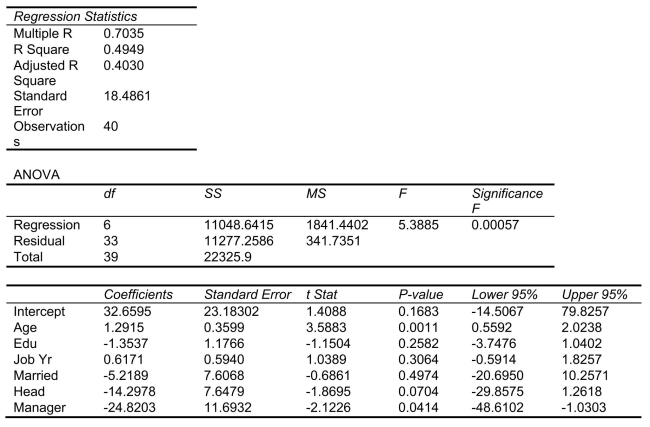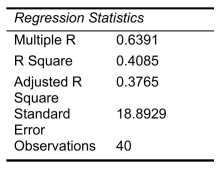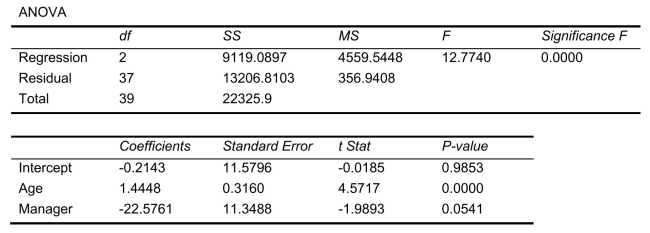SCENARIO 18-10 Given below are results from the regression analysis where the dependent variable is the number of weeks a worker is unemployed due to a layoff (Unemploy)and the independent variables are the age of the worker (Age), the number of years of education received (Edu), the number of years at the previous job (Job Yr), a dummy variable for marital status (Married: 1 = married, 0 = otherwise), a dummy variable for head of household (Head: 1 = yes, 0 = no)and a dummy variable for management position (Manager: 1 = yes, 0 = no).We shall call this Model 1.The coefficient of partial determination  of each of the 6 predictors are, respectively, 0.2807, 0.0386, 0.0317, 0.0141, 0.0958, and 0.1201.
of each of the 6 predictors are, respectively, 0.2807, 0.0386, 0.0317, 0.0141, 0.0958, and 0.1201.  Model 2 is the regression analysis where the dependent variable is Unemploy and the independent variables are Age and Manager.The results of the regression analysis are given below:
Model 2 is the regression analysis where the dependent variable is Unemploy and the independent variables are Age and Manager.The results of the regression analysis are given below: 

-Referring to Scenario 18-10 Model 1, there is sufficient evidence that all of the explanatory variables are related to the number of weeks a worker is unemployed due to a layoff at a 10% level of significance.
Definitions:
Behavioral Perspective
An approach in psychology focusing on observable behaviors and how environmental interactions shape them.
Classical Conditioning
A learning process that occurs when two stimuli are repeatedly paired; a response that is at first elicited by the second stimulus is eventually elicited by the first stimulus alone.
Self-Efficacy
The belief we have in our ability to succeed in a specific task or situation.
Reciprocal Behavior
Behavior that involves responding to another's action with a similar or related action, often related to the principle of reciprocity in social psychology.
Q24: Referring to Scenario 18-10 Model 1, there
Q26: The p chart is a control chart
Q35: The logistic regression equation predicts:<br>A)The probability of
Q58: The cause of variation that can be
Q76: Referring to Scenario 20-6, the optimal strategy
Q86: Which of the following is NOT one
Q88: Referring to Scenario 20-6, what is the
Q89: Referring to Scenario 18-1, one individual in
Q120: Referring to Scenario 16-6, the fitted trend
Q154: Referring to Scenario 18-8, the null hypothesis